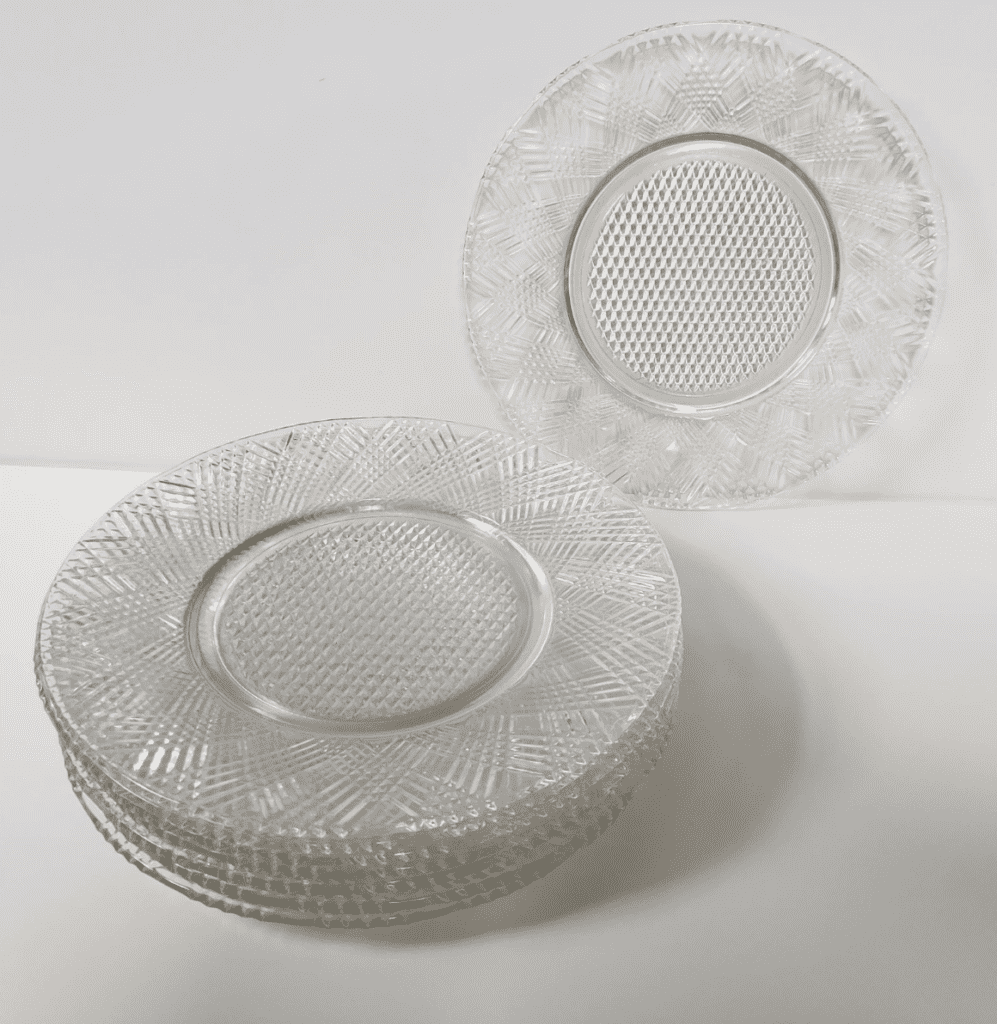Depression-era glass, while originally meant to be inexpensive, mass-produced glassware, has become a valued treasure for antique collectors. Known for its intricate patterns and beautiful translucent colors, depression glass can be difficult to identify in terms of both its authenticity and its producer. Hazel-Atlas Glass was one of the largest glass manufacturing companies during the first half of the twentieth century, and its pieces often get confused with those of other large, popular glass firms, but how do you identify Hazel-Atlas glass?
To identify Hazel-Atlas Glass, look for the H over A glass maker’s mark on the base of the glass. An N or HA mark may have been used before the start of the H over A mark in 1923. Many Hazel-Atlas pieces are not marked, so you’ll have to identify the pattern of the glass to determine if it was a Hazel-Atlas piece.
Keep scrolling for images of the most popular Hazel-Atlas glass patterns as well as some of the glass maker’s marks.

Marks on Hazel-Atlas Glass
The Hazel-Atlas glass maker’s mark is the H over A: a capital H with an A underneath. Its usage began in 1923 and the mark can be found on the base of the piece with different codes surrounding it. The H over A mark will often be found with a 4-digit numerical code that indicates the model or catalog number, and/or a single-digit code that designates which mold design was used.
The company grew to eventually include fourteen different glass plants all over the USA, incorporating various locations from the merger of the Hazel Glass and Atlas Glass companies in 1902 and other firms that were incorporated over time. Subsequently, plants that weren’t originally part of the Hazel-Atlas system marked their products with a letter (K, A, H, O), but there’s no evidence of markings from other plants.
Before the H over A mark began its use in 1923, there’s evidence to suggest the company may have marked its pieces with an “N” or “HA.” Additionally, pieces like jars and bottles that weren’t included in dinnerware sets were often marked with “Hazel” or “Atlas” and the design name in curved lines on the side.
Is Hazel-Atlas Glass Worth Anything?
Most Hazel-Atlas glass pieces are sold for $10-$90, but sets and large, rare pieces can be extremely valuable. The bigger the piece and the rarer the pattern or color on the glass is, the more valuable it will be. Some pieces have been sold for up to $1,500.
Hazel-Atlas Glass Patterns
Here are some of the patterns that can be found on glass made by Hazel-Atlas. The more you know about these patterns, the easier it will be for you to identify glass made by Hazel-Atlas.
Ovide
Ovide is Hazel-Atlas’s plain dinnerware line. The blank pattern was used to make a variety of sets in differing colors, like Sierra or Fiesta color schemes, but only after the company created Platonite, a specific glass-making process that made the finished product opaque rather than transparent. The Ovide pattern was the most widely produced set.
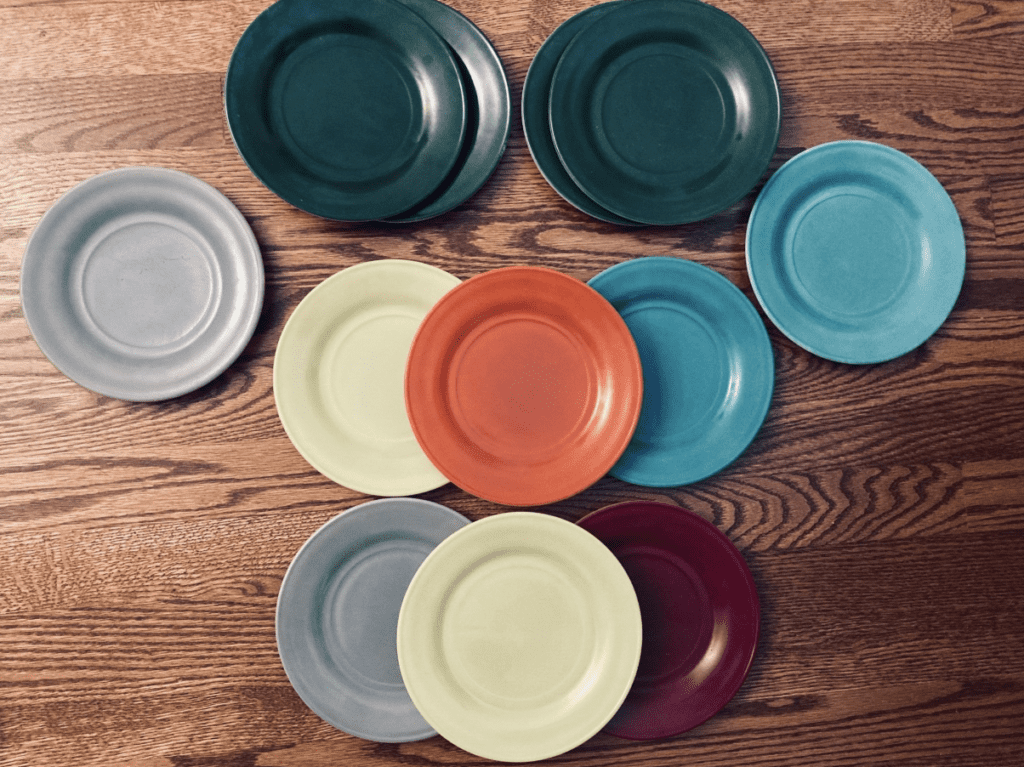
Aurora
Aurora was made during the late 1930s and early 1940s, predominantly in blue, but it was also made in pink, crystal (clear), and green. It’s a small pattern, none of the plates are larger than 6.5″. The full pattern includes a cereal bowl, deep bowl, milk pitcher, cake plate, tumbler, and cup and saucer. It’s intended to be used for snacks or desserts. There will be “horizontal optic ribbing with [concentric ridges] at the tops or edges of pieces,” according to HazelAtlasGlass.com.

Royal Lace
Hazel Atlas produced Royal Lace as early as 1934 in pink, green, clear, and cobalt blue. Royal Lace is a full set including dinner plates, lunch plates, cake plates, two sizes of tumblers, berry bowls, rimmed bowls, cups and saucers, salt and pepper shakers, a cream bowl and lid, a sugar bowl and lid, pitchers, serving bowls, large serving plates, serving platters, and a butter dish. HazelAtlasGlass.com describes the pattern as “a repeating series of three roses inside a draped lace contour with intricate lacy floral design.”

Ribbon
The Ribbon pattern was made most commonly in green, though there are pink, crystal, and black pieces as well. Dinner plates, lunch plates, cups and saucers, tumblers, salt and pepper shakers, candy jars, and cream and sugar bowls were included in the set. The pattern has a raised Ribbon spaced throughout the piece. The green pieces glow under a blacklight as they are uranium glass.
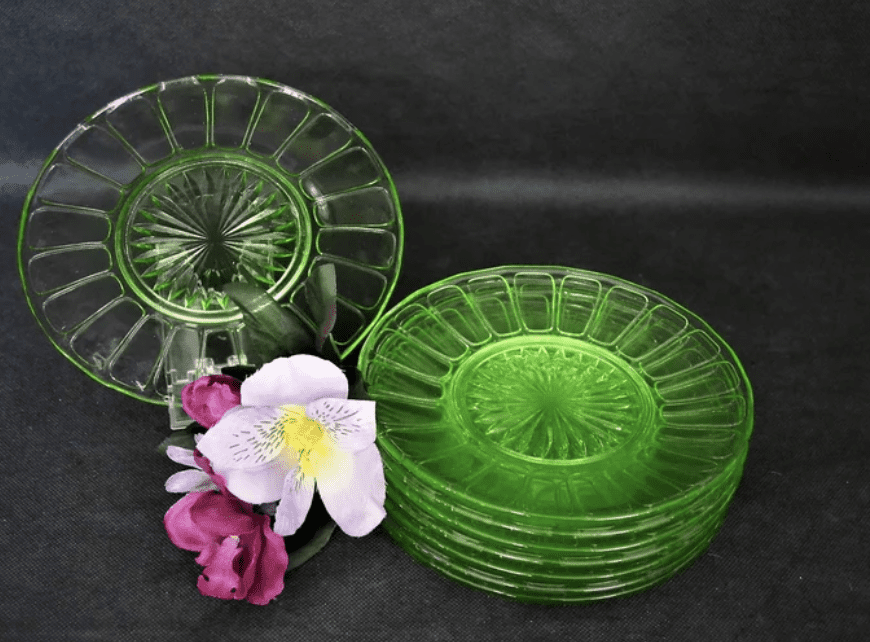
Moderntone
Starting in 1935, Hazel-Atlas made Moderntone in transparent colors and transitioned later to their opaque Platonite glass. The majority of Moderntone pieces are blue. It has a plain banded pattern and Hazel Atlas made full dinner and child dish sets.

The lids for the butter dish, cheese dish, sugar bowl, and mustard jar in Moderntone sets will likely be metal rather than glass, as the lids were added by other companies that bought from Hazel-Atlas.
Moderntone pastel colors were popular in the 1940s and 1950s in opaque platonite glass.
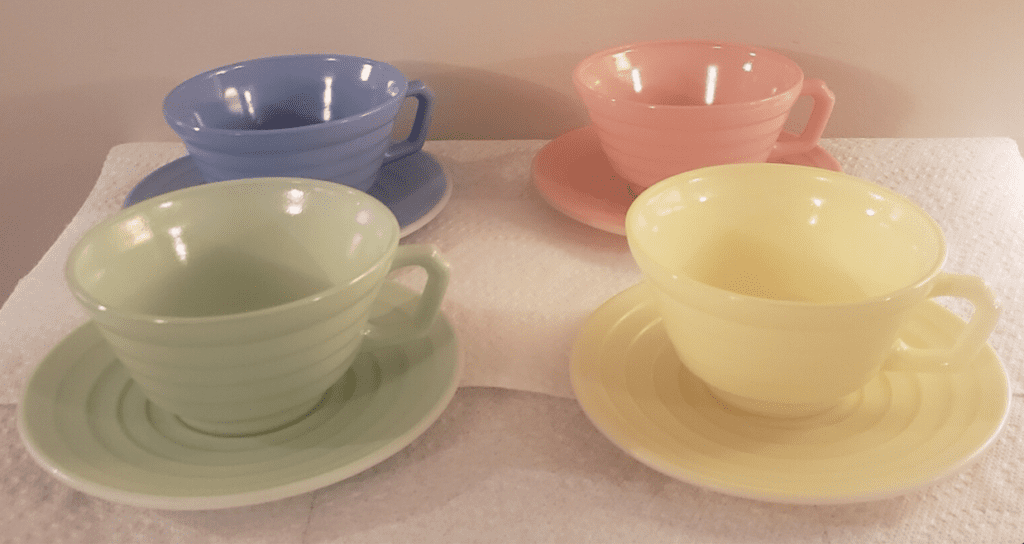
Newport
Hazel-Atlas started producing Newport in 1936 at a much lower rate than its more popular patterns, Royal Lace and Moderntone, first in blue, amethyst, and pink, then in its Platonite colors later.
The set is much smaller and includes cups, saucers, 2 different plate sizes, 5.5″ cereal bowls, an 11.75″ oval platter, an 8/14″ round bowl, salt and pepper shakers, sugar and cream bowls, a sherbert glass, cream soup bowls, berry bowls, sandwich plates, dinner plates, and tumblers. The pattern consists of swooping lines circling the pieces and intersecting in V shapes.

New Century
New Century was produced in the 1930s primarily in green, but also in blue, amethyst, crystal, and pink. The set includes an ashtray and coaster, bowls, a butter dish, cup and saucer sets, a cream and sugar bowl with lid, a decanter, goblets, plates, a platter, pitchers, salt and pepper shakers, a sherbert glass, and tumblers. The pattern consists of vertical and circular embossments emphasizing the lines and simplicity of the pieces.
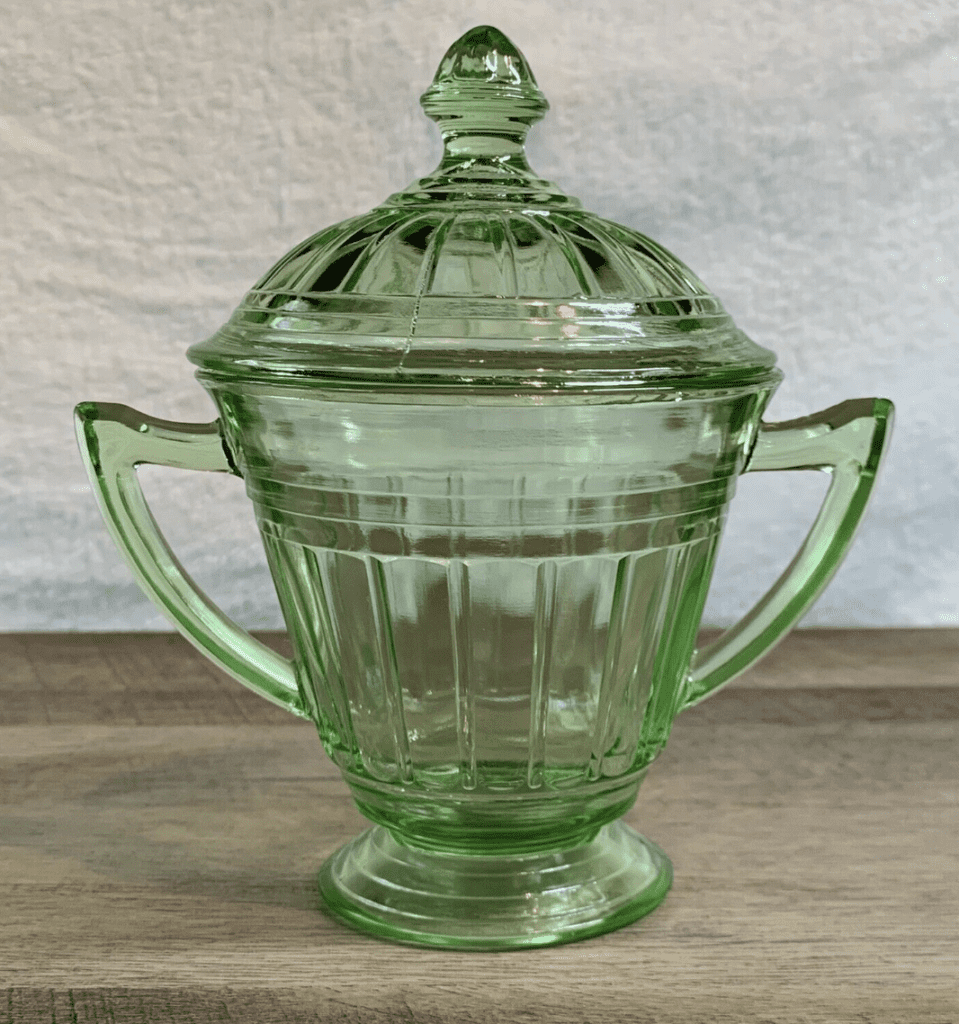
Cloverleaf
This pattern was produced in the mid-1930s predominantly in green, though there are rarer sets in pink and even black. The set includes three differently styled tumblers, a 5″ cereal bowl, a 4″ dessert bowl, cup and saucer sets, 6″ and 8″ plates, a grill plate, creamer and sugar in the Ovide shape, a 7″ wide serving bowl, a shallower 8″ wide serving bowl, salt and pepper shakers, a footed candy jar, and ice tea or sherbert glasses.
They have a distinctive three-leaf clover pattern that encircles each piece, though there can be a random four-leaf clover found on the cereal bowl, cup, and saucer.
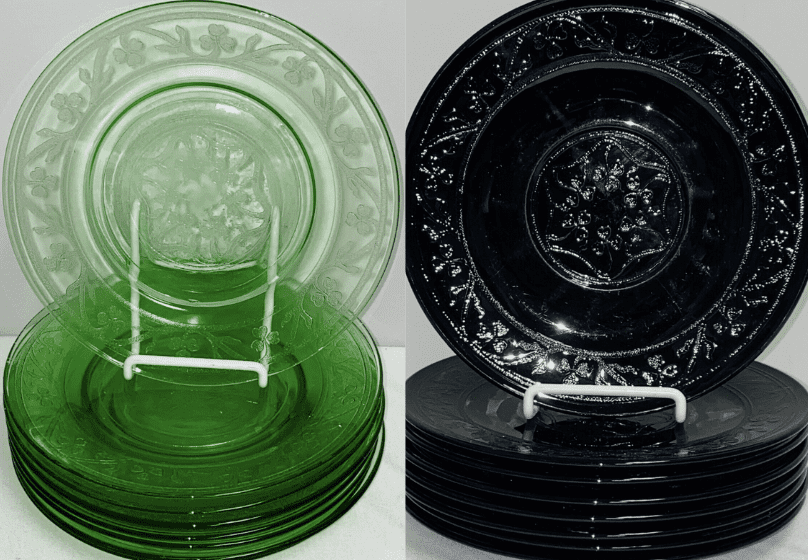
Florentine I and II (Poppy)
Hazel-Atlas began producing this pattern in 1934 originally in pink, then later in green, yellow, and crystal. Dishes for an entire place setting and serving set are included, and, additionally, there is a gravy boat, early cream soup bowls, two-handled bowls, and a grill plate as well.
The pattern is a combination of poppies and vines repeating over each piece; the original pattern came with a plain edge while the later pattern introduced in the early 1940s shows a scalloped edge.
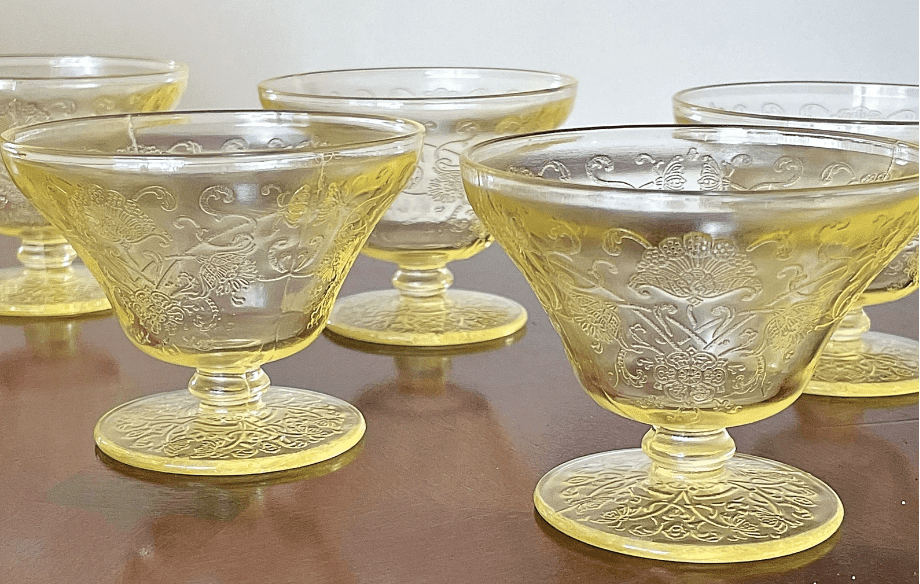
Crisscross
Crisscross was produced mainly in the 1930s in blue, crystal, green, pink, and even amber (rare). It is primarily a kitchenware set that includes mixing bowls, a butter dish, water bottles, reamers, a pitcher, a tumbler, refrigerator dishes, and a creamer and sugar with a lid. The pattern consists of vertical and horizontal lines crossing one another with squares overlaid on each intersection.
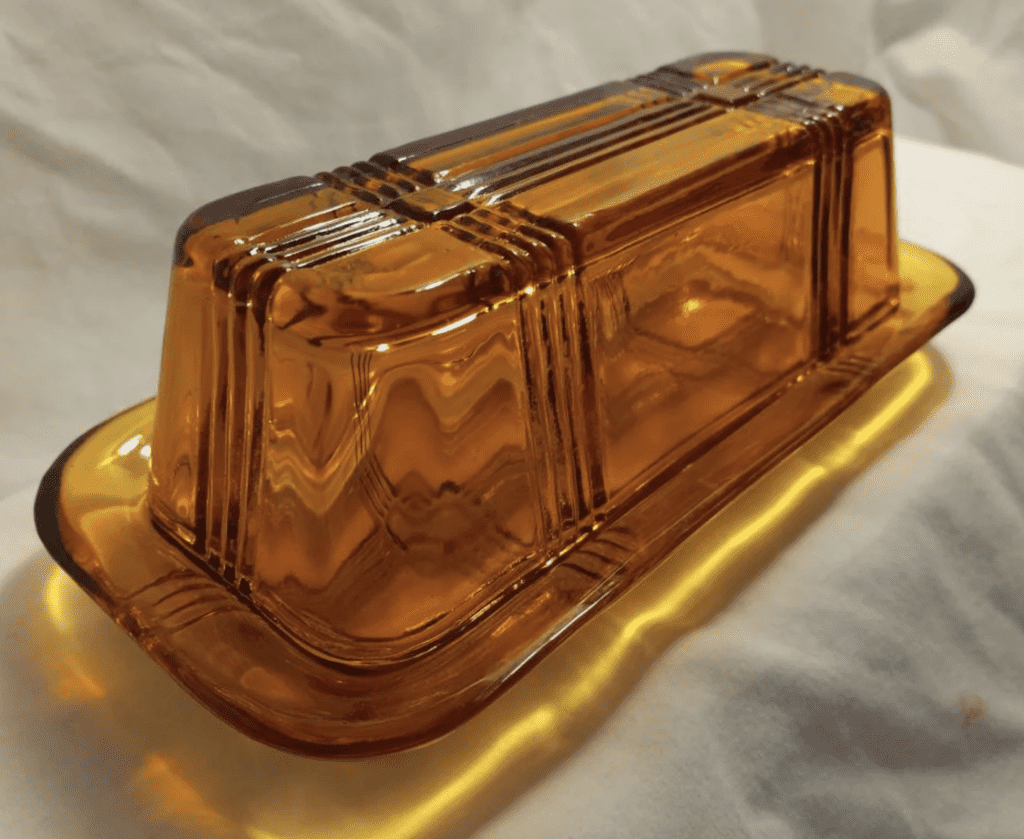
Diamond and Arches
Made during the 1930s, Diamond and Arches were produced in green, pink, and crystal. It’s a fruit bowl set with one larger fruit bowl, 8 to 9″ across, and several smaller fruit bowls, 4.25 to 4.75″ across. The pattern has several large pointed arches circling the base of each bowl with crosshatched diamonds at the bottom of each arch.

Starlight
Produced between 1938 and 1940, Starlight was made primarily in crystal, though also in blue, pink, and white. The set has several different sizes of bowls and plates, a relish dish, a sherbert glass, cup and saucer sets, and a creamer and sugar. The pattern is made up of multiple groups of curving, diagonal lines that intersected to make a crosshatched, diamond pattern.
